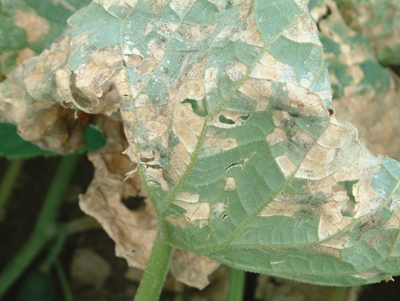
Features
Chemicals
Insects
Weather was tough on crops, growers in 2008
April 30, 2009 By Hugh McElhone
Looking back over 2008’s growing season, producers and researchers alike faced many weather-related challenges, says Janice LeBoeuf, vegetable specialist with the Ontario Ministry of Agriculture, Food and Rural Affairs (OMAFRA).

|
| Downy mildew was prevalent again in cucumbers during the 2008 season. This is an example of downy mildew infection on a cucumber leaf.
|
Looking back over 2008’s growing season, producers and researchers
alike faced many weather-related challenges, says Janice LeBoeuf,
vegetable specialist with the Ontario Ministry of Agriculture, Food and
Rural Affairs (OMAFRA).
According to Environment Canada, southwestern Ontario generally saw
less rain during the month of May with temperatures two degrees cooler
than average. With the exception of the Windsor area, June, July and
August were 30 per cent wetter than normal with a three-month record
rainfall of 396.2 millimetres. The yearly total for southern Ontario
was also a record setter at 995.8 millimetres, easily topping the
previous record of 971 millimetres set in 1977.
There were not many insect calls during the season, says LeBoeuf, but
“there were certainly disease issues.” The wet conditions and storms
proved ideal for spreading bacterial disease through pepper and tomato
fields. “Some grew out of it while others worsened,” she noted.
LeBoeuf says bacterial disease prevention would have been difficult in
some areas last year but timely sprays did minimize effects.
Applications of fixed copper bactericides during greenhouse transplant
production, followed by three applications soon after transplanting,
helps to keep bacterial populations low.
Outbreaks of phytophthora blight were observed last year in a few
fields in Essex County, says LeBoeuf. Zucchini was particularly hard
hit with some fields wiped out. The disease was also seen in peppers in
a few locations in southern Ontario.
The first signs of phytophthora blight in peppers are usually wilted
plant, explains LeBoeuf. Dark discolouration is generally seen on the
stem. Symptoms may also occur on the root, leaves, and fruit. In
zucchini, the crown of the plant may show the first symptoms, but fruit
lesions are common as well. Too much rain is certainly a factor and it
can spread rapidly, she says.
The phytophthora blight pathogen can remain in the soil for a long
time, notes LeBoeuf, and in some areas of the U.S. susceptible crops
cannot be grown in areas so afflicted. When the pathogen is present at
high levels, even long crop rotations may not help. The key is
preventing it from gaining a foothold. Growers should routinely rotate
out of host crops for at least three years between susceptible crops
like cucurbits and peppers. Non-host crops include corn, soybeans,
small grains, and most brassica crops.
While phytophthora blight can move through airborne spores under some
circumstances, by far the most common means of transmission is through
water movement, including surface runoff. The disease can spread
through irrigation if runoff from a diseased field can enter the
irrigation water source.
Raised beds and mulch can help to a certain degree and good drainage is
also beneficial. LeBoeuf suggests to avoid planting in low spots where
water ponds.
Another disease found last summer in tomatoes was buckeye rot. Under
wet conditions, it causes the fruit to develop dark target-like
patterns, usually on fruit close to the soil. There are no fungicides
registered for this disease in Canada.
Downy mildew was found in some cucumber crops last year. LeBoeuf says
30 monitoring sites were set up by OMAFRA vegetable specialist Elaine
Roddy. The first infected field was found by June 20. Roddy issued
regular e-mail and fax updates to growers throughout the season, to
provide the most up-to-date information on controlling downy mildew.
Despite heavy disease pressure for much of the season, cucumber growers were able to maintain good control by following a preventative fungicide program. Tattoo C was available in 2008 under
an emergency use registration. This product used in rotation with
Ranman 400SC provided a good level of protection against downy mildew.
Last year, LeBoeuf monitored a few sites in Essex and Kent counties for
pepper maggot. This pest is occasionally a problem in southern Essex
County, but it is unknown how wide its range is in Ontario, or if it is
present every year.
The pepper maggot leaves egg-laying scars on the skin of the pepper.
When the eggs hatch, the larvae feed inside the fruit prior to dropping
to the soil to pupate.
“The adults can be monitored by placing yellow sticky traps, baited
with ammonia, 20 to 30 feet up in a nearby tree – not a particularly
handy method,” she said.
LeBoeuf will continue the monitoring in 2009 across a wider area.
Print this page